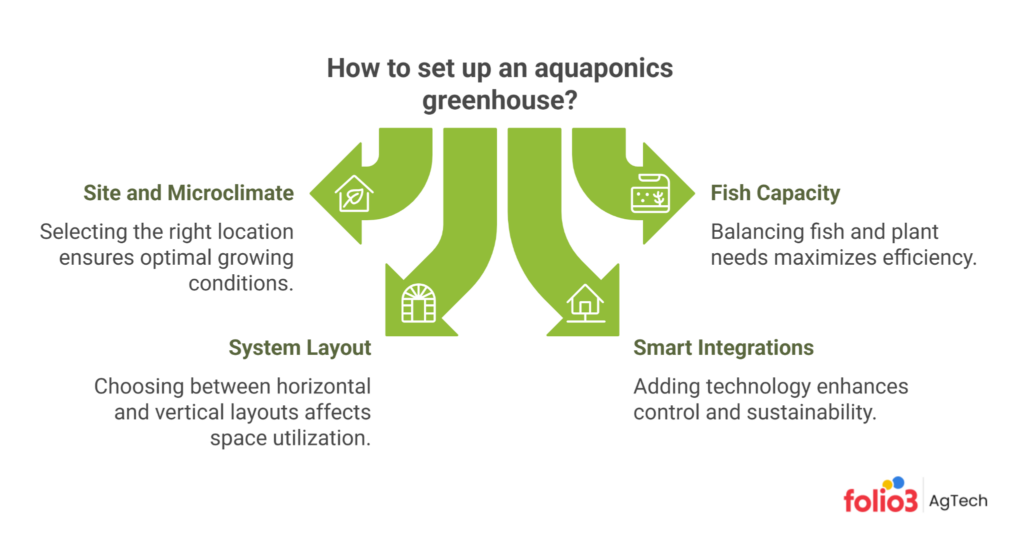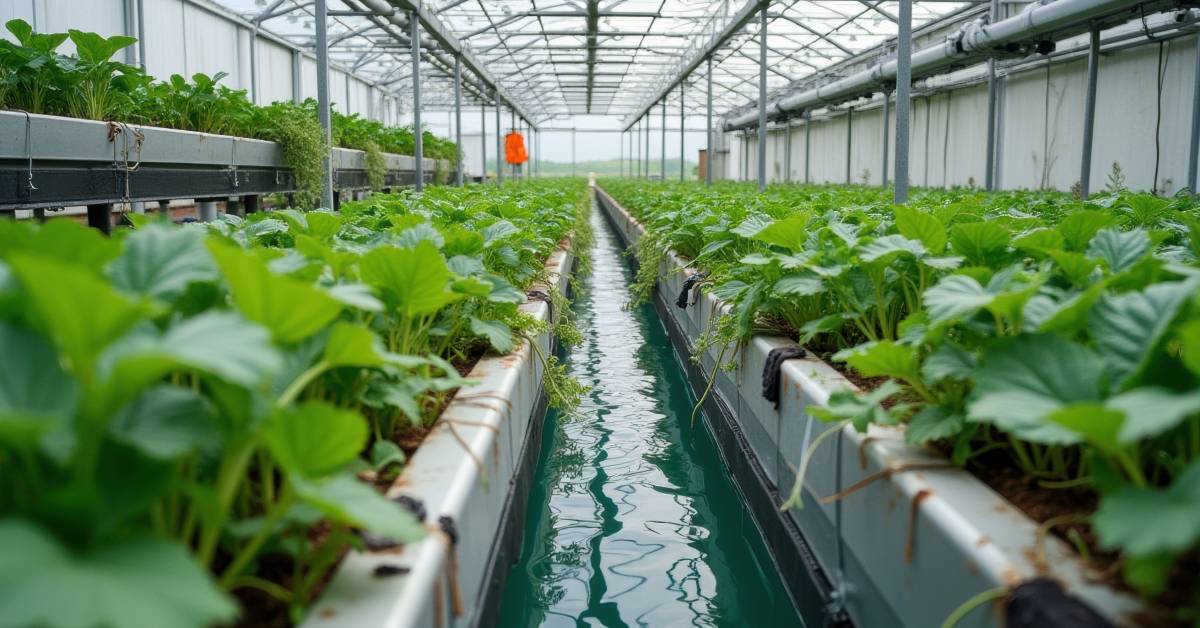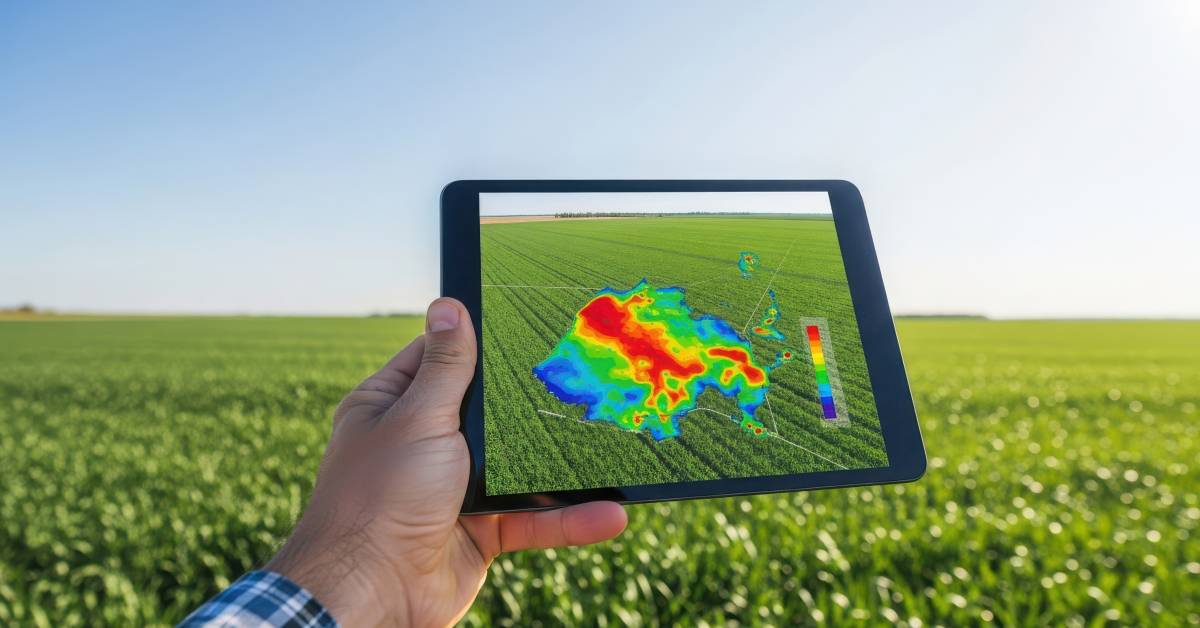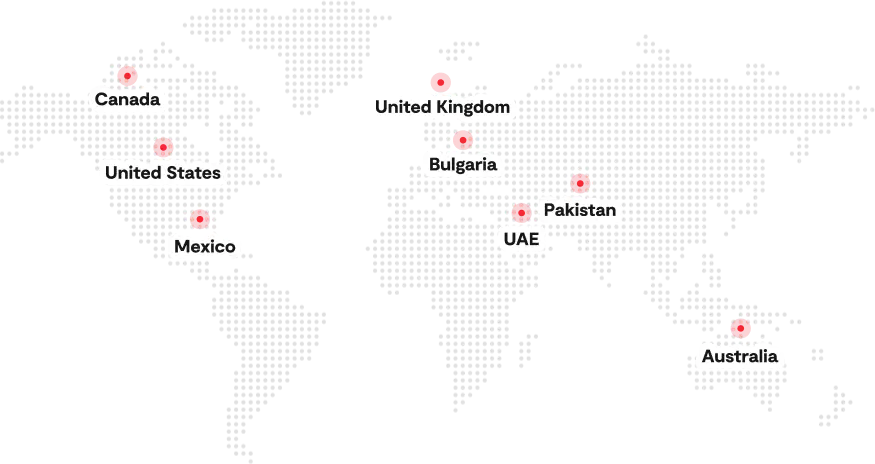Aquaponics greenhouses are gaining steady traction among growers who want high-yield production with lower resource use. The appeal comes from the closed-loop design, where plants and fish support each other biologically, reducing fertilizer dependency and cutting freshwater consumption compared to conventional soil cultivation. This model fits well in regions facing water stress, rising input costs, or unpredictable weather cycles. It also helps farmers maintain year-round production without relying on seasonal growing windows.
Market adoption reflects this shift toward resource-efficient growing systems. The global aquaponics market is valued at USD 1.20 billion in 2025 and is projected to reach USD 2.73 billion by 2034, advancing at a CAGR of 9.50%. This upward trend highlights how growers, investors, and controlled-environment farmers are looking for scalable and climate-resilient alternatives.
In this guide, you will learn how greenhouse aquaponics systems work, the types of greenhouse setups available, what to consider when designing and building one, and how to manage daily operations. The goal is to provide a practical and actionable overview that helps growers build more innovative infrastructure and maximize yield potential through integrated growing.
How Aquaponics Works in a Greenhouse Environment
An aquaponics greenhouse operates through a biological partnership between fish and plants, where nutrient cycling replaces synthetic fertilizers. Fish waste is converted into usable plant nutrients through nitrification. Beneficial bacteria in the biofilter break down ammonia into nitrites and then into nitrates that crops can absorb efficiently through the root zone. Once the plants take up the nutrients, the cleaned water recirculates back to the fish tank, creating a balanced water cycle with minimal discharge or replacement.
Housing the system inside a greenhouse improves environmental consistency, but it also changes how the biology performs. Temperature and humidity have a direct effect on oxygen levels, bacterial activity, and plant nutrient uptake. In practice, greenhouse physics becomes just as important as nutrient cycling. Leafy greens perform best when vapor pressure deficit stays within the 0.6 to 1.2 kPa range, while proper air changes per hour (ACH) or CFM ventilation is needed to prevent moisture stagnation that lowers oxygen transfer in the biofilter.
Light transmission from glazing materials also matters because a higher %PAR ensures predictable growth without stressing the plants. A stable microclimate keeps the bacteria active and the fish-plant cycle efficient, which is why shading, ventilation, and moisture control equipment are used to keep both biomass and microbial activity in sync.
Unlike basic open-air aquaponics, greenhouse aquaponics sits within the broader space of greenhouse farming and overlaps with innovations seen in a hydroponic greenhouse, aeroponic greenhouses, and other controlled environment agriculture models. The key difference is the biological nutrient loop, which creates a soil-free growing method powered by live organisms rather than commercial nutrient salts. With the right climate balance, aquaponics can outperform traditional systems in water-use efficiency, nutrient recovery, and year-round yield reliability.
Steps to Plan Your Aquaponics Greenhouse Setup

1. Choose the Right Site and Microclimate
Location is the most critical early decision because it sets the baseline for consistency inside your aquaponics greenhouse. Look for intense light exposure, natural wind protection, and room for tanks, plumbing, and biofiltration. A south-facing orientation works best in colder regions for solar gain, while a slightly shaded east-west alignment is better in hotter zones. Also ensure the structure meets basic snow and wind load requirements for your area.
2. Match Fish Capacity With Plant Demand
Sizing is not about tank volume alone. It is about nutrient balance. Overstocking fish leads to ammonia overload, while too few fish starve the plants of nitrogen. Stocking density, filtration surface area, and flow rate must scale together to maintain equilibrium as the system matures.
3. Choose a System Layout: Horizontal or Vertical
Media beds and raft systems are standard horizontal layouts because they are simple and easy to manage. Stacked towers or shelving-based production unlock the benefits of vertical farming, especially when the footprint is limited or when leafy greens are the primary output.
4. Add Smart Structural and Climate Integrations
Modern builds incorporate monitoring tools, ventilation automation, and energy-efficient upgrades. These greenhouse integrations maintain airflow, humidity balance, and light uniformity while also stabilizing biofilter performance. A modular upgrade path works best for first-time growers, allowing the system to scale as capacity and market demand grow.
How to Build an Aquaponics Greenhouse
Building an aquaponics greenhouse starts with a stable frame and foundation that can support tanks, plumbing, insulation, and environmental controls. Most growers choose steel, aluminum, or treated wood frames depending on climate and budget. The aquaponics greenhouse shell should prioritize light transmission, UV stability, and interior condensation control because moisture levels stay high in closed-loop food production.
1. Install the Tanks and Grow Beds
The fish tank, sump tank, and grow beds form the main nutrient loop. Positioning should allow gravity-fed circulation whenever possible to reduce pump wear. Raft beds, media beds, or nutrient film channels can be used depending on crop type and space. This is where structural load matters, especially in medium- or large-scale aquaponics greenhouse builds.
2. Add the Biofilter and Circulation Components
A functioning aquaponics greenhouse system depends on bacterial nitrification, so the biofilter surface area must be correctly sized. Water movers, clarifiers, and swirl filters help maintain clarity and oxygen levels. Aeration stones or diffusers should be placed near heavy fish density zones to avoid stress and ammonia spikes.
3. Set Up Plumbing and Aeration
The plumbing loop requires consistent flow between tanks and grow beds. PVC is the most common material in aquaponics greenhouse systems because it handles moisture and temperature fluctuations well. Backup aeration is recommended to protect stock during power outages or high heat periods. Once flow is balanced, cycling-in starts the microbial ecosystem that drives production.
4. Lighting and Climate Management
Supplemental lighting is essential in low-sun or winter regions where greenhouse yield depends on extending daylight hours. Lighting strategy should match crop type and photoperiod needs. Climate control also includes shading, ventilation, and greenhouse pest control methods that rely on airflow management and barrier screening rather than heavy pesticides.
5. Compliance and Safety
Water quality logs, electrical safety, and biosecurity steps become increasingly crucial as systems scale. This is also where growers begin to see the distinction between horticulture vs agriculture, since aquaponics demands plant and livestock management together rather than viewing them as separate operations.
By following these structured steps, beginners can learn exactly how to build an aquaponics greenhouse in a way that protects both fish health and plant consistency while setting the foundation for efficient production later in the season.
How to Actively Manage an Aquaponics Greenhouse
Once construction is complete, the success of an aquaponics greenhouse depends on how consistently the system is managed day to day. The first layer of control is environmental. Temperature and humidity inside the greenhouse influence fish metabolism, nutrient cycling, and plant respiration. If swings are too broad, nitrifying bacteria slow down, and nutrient delivery falls behind plant demand. Ventilation, shading, and thermal buffering are used to keep conditions stable.
Water chemistry is the second central pillar. pH, dissolved oxygen, ammonia, nitrite, and nitrate must remain in balance to protect fish health while ensuring steady nutrient availability to crops. A drop in dissolved oxygen can stress fish even before visible symptoms appear, which is why aeration and flow checks are part of daily monitoring. Testing pH regularly also prevents micronutrient lockout, which is a frequent cause of stalled plant growth in beginner systems.
Fish condition and plant uptake must be aligned. If fish feeding is too heavy, ammonia accumulates before the biofilter can convert it, which leads to toxicity. If feeding is too light, nutrients become insufficient, and leafy crops show slow color loss or tip burn. Matching stocking density to plant load keeps the loop biologically stable over time.
Continuous monitoring routines also support fresh produce quality control, since early stress shows up in taste, texture, and shelf life long before yields drop. Management habits tie directly into sustainable crop production, because a well-tuned system uses less water, reduces off-farm inputs, and maintains long-term biological stability without heavy external correction.
Active greenhouse management is therefore not only about reacting to problems but guiding the ecosystem into equilibrium. With consistent measurement, small adjustments, and proactive observation, growers protect both fish vitality and plant performance, which is what ultimately drives reliable output in every aquaponics greenhouse.
Crop Selection and Fish Selection Strategies
Choosing the right crop and fish combination is what determines long-term stability in an aquaponics greenhouse. Leafy greens, herbs, and fast-maturing vegetables are typically the best-performing greenhouse species because they have a high nutrient uptake rate and tolerate the steady moisture conditions that aquaponics provides. Lettuce, basil, pak choi, kale, and mint remain the most consistent performers for year-round production, while fruiting crops like tomatoes and peppers require higher nutrient density and more vigilant monitoring to avoid deficiencies. Success also starts with smart seed selection, since disease resistance and germination vigor directly affect overall system performance.
Fish selection follows the same logic. Species that tolerate variable water parameters perform better in closed-loop systems, which is why tilapia, catfish, trout, and koi are the most common choices. They are hardy, easy to feed, and produce a steady nutrient output through their waste stream. Matching stocking density to plant load is essential because the fish are the nutrient engine for the plants. If biomass production is not aligned with crop demand, the entire loop slips out of balance.
Overstocking causes ammonia spikes, low dissolved oxygen, and eventual fish stress. Understocking leads to nutrient dilution that forces plants into slow growth and pale coloration. The sweet spot is achieved by starting conservatively, observing uptake rates, and scaling the number of fish in stages.
Avoiding system imbalance also means accounting for growth speed. Plants mature faster than fish, so harvesting schedules should not outpace nutrient generation. By planning species in clusters based on maturity time and nutrient draw, growers maintain a stable cycle that supports healthy output across both sides of the system.
Maximizing Yields Through Data and Maintenance
Maximizing yield in an aquaponics greenhouse depends on consistent tracking and small but well-timed adjustments. Instead of reacting to problems late, growers maintain performance by observing patterns early and tuning the system accordingly.
Growth tracking
- Detects slow uptake, nutrient imbalance, or stress early
- Builds a performance baseline across multiple seasons
System tuning
- pH, dissolved oxygen, and nutrient levels are monitored routinely
- Fish feeding rates and aeration can be adjusted as plant demand increases
Proactive maintenance
- Pumps, aerators, and biofilters are checked to avoid friction and downtime
- A structured maintenance routine keeps the system stable and predictable
By combining real-time data with preventive upkeep, aquaponics greenhouses steadily improve yield potential while protecting the long-term health of both fish and plants.
Key Mistakes to Avoid in Aquaponics Greenhouses
Avoiding the most common system errors is just as crucial as managing nutrients and stocking balance. Many aquaponics failures start with basic missteps that slowly destabilize the system over time.
Overfeeding
Excess feed increases ammonia levels and clogs the system. Fish eat far less than most growers assume, especially during temperature dips. When uneaten feed begins to decay, it stresses the fish and overloads the biofilter.
Insufficient Oxygenation
Aquaponics relies on dissolved oxygen for both fish respiration and bacterial conversion of ammonia. Low aeration weakens fish immunity and slows nitrification, which eventually reduces nutrient availability for plants.
Neglecting Biofilter Care
The biofilter is the biological engine of the aquaponics greenhouse. If it is not cleaned, sized correctly, or seeded properly, conversion stalls and ammonia or nitrite spikes begin to appear. A stable biofilter is non-negotiable for long-term performance.
Poor Cycling Timing
Cycling too fast or adding fish before nitrifying bacteria are fully active leads to system shock. The nitrogen cycle must be established before stocking at full capacity. Skipping this step forces the system into recovery instead of healthy growth from day one.
By watching for these errors early and optimizing management habits around them, operators maintain stability and prevent avoidable crashes that set growth back for weeks.
How Folio3 Agtech Supports Aquaponics Greenhouse Management
An aquaponics greenhouse operates as a living ecosystem, which means timing, balance, and precision are everything. Folio3 Agtech’s greenhouse management software helps growers monitor the full loop, from fish health to plant nutrition, while reducing the guesswork that typically slows down decision-making. By pairing real-time environmental data with performance insights, it supports more stable yields and healthier system biology across the season. This is especially valuable in an aquaponics greenhouse, where even small fluctuations in pH, temperature, or dissolved oxygen can have compounding effects on both fish and plants.
Key Features include:
- Real-Time Environmental Monitoring
- Water Quality Parameter Tracking
- Fish Health and Stocking Dashboard
- Crop Growth and Yield Logs
- Automated Alerting and Threshold Rules
- Biofilter Performance Insights
- Maintenance and Task Scheduling
- Traceability Logs and Digital Records
By consolidating monitoring and management into a single platform, Folio3 Agtech gives growers a more predictable and data-backed way to operate an aquaponics greenhouse at scale. The software strengthens day-to-day oversight while supporting long-term system stability, setting up the perfect transition into our next section, where we recap the core benefits and bring the guide to a close.
Conclusion
An aquaponics greenhouse succeeds on balance, precision, and consistency. Unlike traditional growing systems that isolate crop and fish production, aquaponics requires a unified approach where every parameter is interconnected. Water quality affects nutrient delivery, nutrient delivery influences plant growth, and plant uptake affects fish health. When managed correctly, this creates one of the most efficient food production ecosystems available today. The controlled environment of an aquaponics greenhouse also enables year-round growing, higher predictability, and stronger biological resilience in regions where conventional agriculture struggles.
What separates high-performing systems from average ones is the level of monitoring, planning, and responsiveness built into daily operations. A well-run aquaponics model turns maintenance into optimization by continuously improving plant density, biofilter efficiency, stocking ratios, and environmental stability. This leads to healthier biology, cleaner conversions, and lower long-term input cost per kilogram of output. For growers intending to scale, innovative data use becomes just as important as infrastructure.
As market demand for sustainable, resource-efficient food production continues to rise, an aquaponics greenhouse provides a defensible model that combines profitability with ecological responsibility. It offers a pathway not just to higher yields but to more adaptable and future-ready farming systems.
FAQs
What Is Aquaponics in a Greenhouse?
It is the integration of aquaculture and hydroponics inside a controlled structure where fish waste fertilizes plants and plants naturally filter water for the fish. Housing the system indoors stabilizes temperature, water quality, and growth cycles.
Can You Do Aquaponics in a Greenhouse?
Yes. In fact, a greenhouse is one of the most efficient environments for aquaponics because it protects the biology from weather swings, improves water temperature regulation, and supports year-round food production.
What Are the 5 Disadvantages of Aquaponics?
The 5 disadvantages of aquaponics are as the follows:
1. Higher initial setup cost
2. Sensitive to water-quality fluctuations
3. Requires ongoing monitoring
4. Power outages can threaten the system
5. Limited crop choice compared to soil farming
What Is the Best Greenhouse for Aquaponics?
The best option depends on climate and budget, but the most effective systems usually use a polycarbonate or high-tunnel structure with sound insulation, automated ventilation, and condensation control. The goal is to maintain a stable environment so fish, bacteria, and plants stay in balance.
Are Aquaponic Fish Healthy to Eat?
Yes. Because aquaponics relies on clean water and biological filtration instead of heavy chemical use, fish are typically raised in low-stress, low-contaminant conditions, which makes them safe and healthy for consumption.







